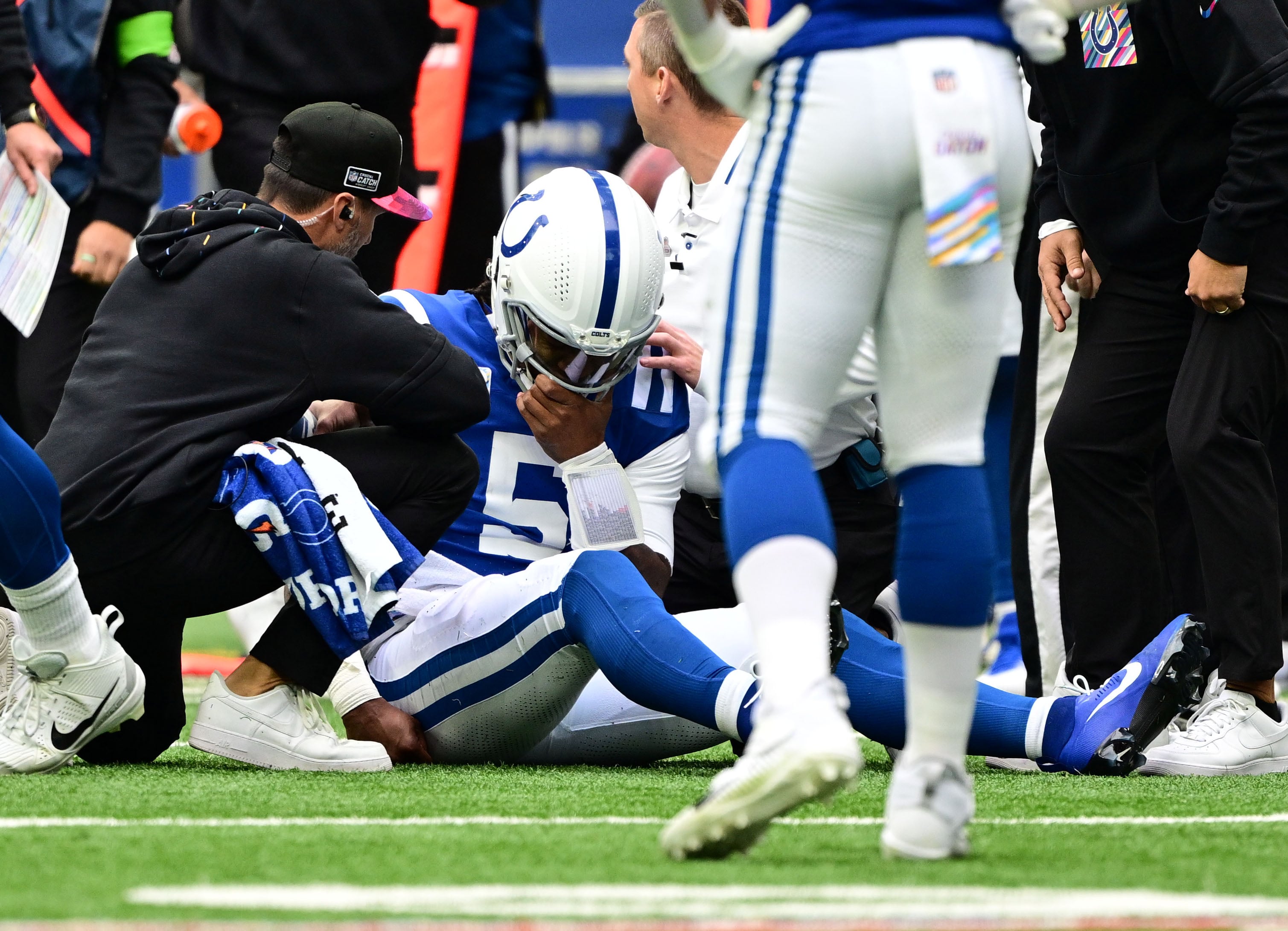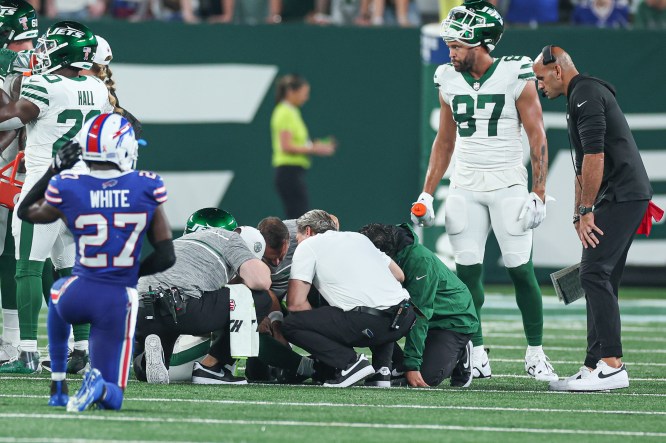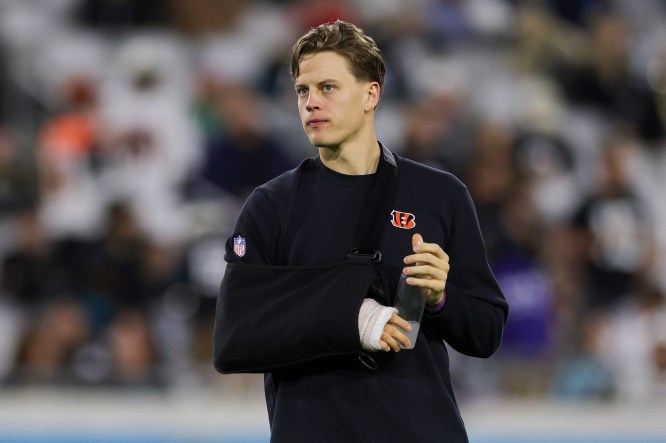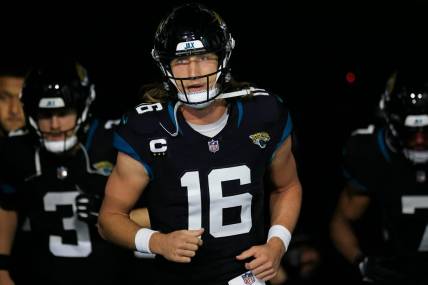As Jacksonville Jaguars quarterback Trevor Lawrence was helped off the field Monday night after severely injuring his ankle, it was just another scene becoming all too familiar, another glimpse into a disturbing trend surrounding NFL quarterback injuries this season.
Lawrence was diagnosed with a high ankle sprain on Tuesday and appears to have dodged what could have been a more catastrophic outcome. Still, it adds to the growing number of NFL quarterback injuries that has plagued the 2023 NFL season, leading us to ask a question: Despite the NFL’s efforts to safeguard quarterbacks through strict rules and safety measures, why are we witnessing such a high occurrence of injuries?
While the league continues to build around, and pay high dollars to, dynamic quarterbacks, something is causing more injuries when the NFL has done more than ever to protect their high-profile assets.
NFL quarterback injuries reach apex in 2023

Starting quarterback injuries have always been a concern in the NFL, but based on data from the NFL, the 2023 season has seen a glaring rise in such occurrences.
This season, the number of starting quarterbacks who have missed games due to injuries has gone up by 30 percent compared to both the 2021 and 2022 seasons. This sudden increase is certainly an outlier when compared to data from the previous seasons.
More starting QBs than ever
Through Week 13, 53 quarterbacks have started at least one game. At the current rate, an all-time high of 73 QBs will start this season.
| 2023 | 73* | 2019 | 57 | 2015 | 53 |
| 2022 | 69 | 2018 | 55 | 2014 | 54 |
| 2021 | 63 | 2017 | 57 | 2013 | 52 |
| 2020 | 58 | 2016 | 54 | 2012 | 49 |
To provide some context, comparing 2023 to the past five NFL seasons, we can see a consistent rate of quarterback injuries. Occasionally, there have been spikes in injuries due to incidents or unusual events.
What makes the 2023 season noteworthy, however, is not the high number of injuries, but also the severity and duration of these injuries, especially to key players.
That includes the Achilles injuries to Aaron Rodgers in Week 1 and Kirk Cousins of the Minnesota Vikings in Week 8, in addition to the wrist injury to Cincinnati Bengals starter Joe Burrow, the shoulder injury to DeShaun Watson in Cleveland, and a season-ending knee injury to Colts rookie QB Anthony Richardson. All of these injuries had significant impacts on the teams and their seasons.
Surgery was a success! Grateful for your prayers, Dr. Coetzee’s abilities, and our medical team. Would appreciate continued prayers! One day at a time… pic.twitter.com/prVoPwLsfB
— Kirk Cousins (@KirkCousins8) November 1, 2023
As the concern grows, so does the search for answers. The increase in injuries among quarterbacks not only affects team performance, but also fan involvement. It also raises concerns about player safety and the efficiency of existing training and conditioning methods and rules.
The causes for the uptick in NFL quarterback injuries

Dr. David Chao, an NFL team doctor for over 17 years, currently runs Sports Injury Central and is a live injury analyst covering the NFL, MLB, NBA and college football, is quick to point out that not one factor is responsible for why injuries have risen. He also makes the point the position has changed, and so, of course, quarterbacks today sustain more injuries than they have in the past.
“When I was actively in the NFL, you had a handful of pocket quarterbacks, right,” Chao told me in an interview with Sportsnaut. “You had Phillip Rivers, Peyton Manning, Eli Manning, Tom Brady. Name one true just pocket quarterback now. But once you become a runner, and are trying to extend plays outside the pocket, you’re a runner and things change.”
He also points to the fact these new mobile quarterbacks who often leave the pocket experience a new physical challenge — defenders attacking them from every angle. That’s a lot more stress and punishment than quarterbacks have ever faced before.
“When you’re running back, you’re used to carrying the ball, you hold it on the outside arm, and you for the most part, people are coming in from 180 degrees at most,” Chao said. You’re running a sweep to the left. You’re you’re coming here or there. You’re running up the middle. Mostly, it’s all the actions in front of you. In comparison, a quarterback now has the actions behind him to the side of him and in front of him. It’s very different than you’ve seen in the past for quarterbacks like those pocket passers.”
Several factors contribute to this concerning trend of NFL quarterback injuries, with changes in training regimens and league policies being at the forefront.
Here are some of the underlying reasons why the trend in quarterback injuries may be on the rise:
- Shorter Training Camps and Preseason Preparation: The NFL and the NFLPA have consistently cut the length and amount of contact during preseason activities. These changes aim to minimize wear and tear. Still, there is concern that players may be less conditioned for the physical demands of regular season games, especially quarterbacks who rarely see time during the preseason and are protected from contact during those periods as well.
- Changes in Gameplay and Offensive Strategies: It’s easy to see the shift toward more dynamic pass-heavy offenses, which inherently expose quarterbacks to more significant risks. With three, four and even five-receiver sets, quarterbacks can be exposed more to pass rushers and injury with fewer blockers. In fact, according to Pro Football Reference, we’re also seeing a sack surge in the league in 2023 with a 77.5 sacks per week average (through Week 13) compared to just 66.8 per week back in 2020. “We have to ask if offensive lineman are as good as they once were in pass sets,” Chao said. “Because you look at the college game, they don’t do that.” As quarterbacks take on an active role in advancing the ball, focusing on their mobility for viability in today’s game, they become more vulnerable to hits and injuries.
- Defensive Evolution: Defenses across the league have adjusted to the changing nature of offenses. With more aggressive defensive strategies aimed at stopping spread and pass-heavy offenses, quarterbacks face increased pressure, resulting in more hits and sacks. Not only that, the speed on defense from hybrid linebackers/safeties also brings an athleticism to defense not seen before. Even with the myriad of rules to protect them, quarterbacks still take more punishment than ever before.
- Physical and Mental Fatigue: The NFL has continually extended the league’s year, meaning more games and more opportunity for fatigue and injury. With a 17-week regular season, followed by an expanded playoffs format (from 12 teams to 14 in 2020), the intensity and duration of the NFL season can lead to both mental fatigue. This fatigue increases the risk of injury. The combination of games, with limited recovery time, exacerbates this issue. This is why many players and coaches have expressed concern over Thursday night games, which sometimes mean a player can play on a Sunday and have just three days to recover before having to take the field again.
- Training and Conditioning Protocols: Concerns have also been raised regarding the adequacy of training and conditioning protocols in the NFL. Are teams dedicating resources to prevent quarterback-specific injuries? Given the changing nature of the game, it may be worth reevaluating this area. The quarterbacks of 2023 are different from those in the 1980s, when they were primarily pocket passers.
What can be done to prevent injuries in the future?

Given the increasing number of quarterback injuries during this NFL season, the focus must now be on how to prevent them as much as humanly possible. Football is a violent sport, and while injuries are never completely preventable, the league and its players must find ways to minimize them.
Chao reiterated the need for better conditioning and rehab but also recommended another more futuristic approach.
“I think one of the best things a quarterback can do to protect themselves and to succeed in the NFL is to learn how to get the ball out as fast as they can,” Chao said. “Because of the lack of reps, many of these quarterbacks get virtual reality training, which could help supplement that.”
More practically, Chao said quarterbacks must learn to make better decisions on when to extend plays and when not to. With the pressure to perform and create plays outside the pocket growing, this decision making could mean the difference between succeeding and finding yourself injured.
As mentioned, according to the NFL rule book, quarterbacks are the most protected players on the field. Exploring more rules to protect the quarterback seems impossible unless you change gameplay altogether.
So what else can be done? Here are a few areas the NFL and NFLPA should explore:
- Enhanced training and conditioning: It is crucial for teams to invest in training programs that focus on improving the durability and resilience of quarterbacks. Customized physical conditioning approaches could significantly reduce the risk of injuries, and the quarterbacks should face more light contact before the start of the season. Yes, that opens up the possibility of injuries too, but it’s a necessary way of preparing them for the rigors of a long season.
- Embrace technological advancements: The use of technology in protective gear and equipment specifically designed for quarterbacks is paramount. While there have been advances in helmet gear, protective gear for the legs, feet and arms is a possible area of discovery. Leveraging these innovations can revolutionize player safety shielding them from injuries. This includes the use of virtual reality like Chao mentioned which has been used in college at Stanford and others.
- Comprehensive health support: Because there doesn’t seem any way the NFL goes backward on the length of the season and the money it brings in, more should be done to support the quarterback’s overall health. It’s not only physical well-being that matters — mental health also plays a crucial role in overall fitness. Adopting a new approach to health encompassing both physical and mental aspects is vital for preventing injuries.
- Change gameplay rules on the offense: It’s hard to fathom more quarterback-specific rules preventing more injuries. With defensive players unable to breathe on a quarterback these days, the only other option would be to limit offenses to afford the quarterback more blockers. This would mean changing rules to favor those alignments. That is a long shot in the pass-heavy NFL, which generates enormous TV ratings and revenue with these high-flying passing games. Yet it could help minimize the injuries we’ve seen this season.
The 2023 NFL season has brought attention to the vulnerability of its quarterbacks, who not only influence the game but also represent the face of the league. The increase in injuries is not merely a statistic; it serves as a message that calls for thorough examination of training methods, game strategies and player safety protocols.
It is imperative for the NFL to acknowledge that its star players are at risk and take action to protect their well-being and longevity on the field.
While the answers to why there’s been a rapid rise in injuries may be complex and numerous, it is now incumbent upon the NFL to step up and fully commit to creating an environment where its greatest talents can thrive without constant concern over potential injuries.
